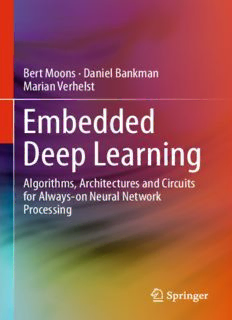Table Of ContentBert Moons · Daniel Bankman
Marian Verhelst
Embedded
Deep Learning
Algorithms, Architectures and Circuits
for Always-on Neural Network
Processing
Embedded Deep Learning
Bert Moons • Daniel Bankman (cid:129) Marian Verhelst
Embedded Deep Learning
Algorithms, Architectures and Circuits
for Always-on Neural Network Processing
123
BertMoons DanielBankman
ESAT-MICAS DepartmentofElectricalEngineering
KULeuven StanfordUniversity
Leuven,Belgium Stanford,CA,USA
MarianVerhelst
ESAT-MICAS
KULeuven
Leuven,Belgium
ISBN978-3-319-99222-8 ISBN978-3-319-99223-5 (eBook)
https://doi.org/10.1007/978-3-319-99223-5
LibraryofCongressControlNumber:2018956280
©SpringerNatureSwitzerlandAG2019
Thisworkissubjecttocopyright.AllrightsarereservedbythePublisher,whetherthewholeorpartof
thematerialisconcerned,specificallytherightsoftranslation,reprinting,reuseofillustrations,recitation,
broadcasting,reproductiononmicrofilmsorinanyotherphysicalway,andtransmissionorinformation
storageandretrieval,electronicadaptation,computersoftware,orbysimilarordissimilarmethodology
nowknownorhereafterdeveloped.
Theuseofgeneraldescriptivenames,registerednames,trademarks,servicemarks,etc.inthispublication
doesnotimply,evenintheabsenceofaspecificstatement,thatsuchnamesareexemptfromtherelevant
protectivelawsandregulationsandthereforefreeforgeneraluse.
Thepublisher,theauthors,andtheeditorsaresafetoassumethattheadviceandinformationinthisbook
arebelievedtobetrueandaccurateatthedateofpublication.Neitherthepublishernortheauthorsor
theeditorsgiveawarranty,expressorimplied,withrespecttothematerialcontainedhereinorforany
errorsoromissionsthatmayhavebeenmade.Thepublisherremainsneutralwithregardtojurisdictional
claimsinpublishedmapsandinstitutionalaffiliations.
ThisSpringerimprintispublishedbytheregisteredcompanySpringerNatureSwitzerlandAG
Theregisteredcompanyaddressis:Gewerbestrasse11,6330Cham,Switzerland
To Lise
Preface
Although state of the art in many typical machine learning tasks, deep learning
algorithmsareverycostlyintermsofenergyconsumption,duetotheirlargeamount
of required computations and huge model sizes. Because of this, deep learning
applications on battery-constrained wearables have only been possible through
wireless connections with a resourceful cloud. This setup has several drawbacks.
First,thereareprivacyconcerns.Cloudcomputingrequiresuserstosharetheirraw
data—images,video,locations,speech—witharemotesystem.Mostusersarenot
willing to do this. Second, the cloud-setup requires users to be connected all the
time, which is unfeasible given current cellular coverage. Furthermore, real-time
applications require low latency connections, which cannot be guaranteed using
the current communication infrastructure. Finally, wireless connections are very
inefficient—requiringtoomuchenergypertransferredbitforreal-timedatatransfer
on energy-constrained platforms. All these issues—privacy, latency/connectivity,
and costly wireless connections—can be resolved by moving towards computing
attheedge.Findingwaystodothisisthemaintopicofthisdissertation.Itfocuses
ontechniquestominimizetheenergyconsumptionofdeeplearningalgorithmsfor
embeddedapplicationsonbattery-constrainedwearableedgedevices.
Computing in the edge is only possible if these deep learning algorithms can
be run in a more energy-efficient way, within the energy and power budget of
the computing platform available on a wearable device. In order to achieve this,
severalinnovationsarenecessaryonalllevelsofanapplication’sdesignhierarchy.
Smarterapplicationscanbedevelopedformorestatisticallyefficientdeeplearning
algorithms, which in turn should run on optimized hardware platforms built on
specifically tailored circuits. Finally, designers should not focus on any of these
fieldsseparatelybutshouldco-optimizehardwareandsoftwaretocreateminimum
energy deep learning platforms. This book is an overview of possible solutions
towardsdesigningsuchsystems.
Leuven,Belgium BertMoons
Stanford,CA,USA DanielBankman
Leuven,Belgium MarianVerhelst
May2018
vii
Acknowledgments
The authors would like to thank several people and institutions for their valuable
contributionstothiswork.
We thank Tom Michiels, Edith Beigne, Boris Murmann, Wim Dehaene, Tinne
Tuytelaars,LudoFroyen,andHugoHensfortheircommentsanddiscussion.IWT,
intel,Qualcomm,andSynopsysfortheirfunding,software,andsupport.Thanksto
FlorianDarveandMarie-SophieRedonatCEA-LETIandtoEtienneWoutersand
LucFolensatimec/IC-Linkfortheirback-endsupportinASICdesign.
We would also like to acknowledgeall coauthorsfor their contributionsto this
manuscript.ThankstoKoenGoetschalckx,NickVanBerckelaer,BertDeBraban-
dere,LitaYang,RoelUytterhoeven,MartinAndraud,andStevenLauwereins.
ix
Contents
1 EmbeddedDeepNeuralNetworks......................................... 1
1.1 Introduction ............................................................. 1
1.2 MachineLearning....................................................... 2
1.2.1 Tasks,T ......................................................... 3
1.2.2 PerformanceMeasures,P ...................................... 3
1.2.3 Experience,E ................................................... 3
1.3 DeepLearning........................................................... 4
1.3.1 DeepFeed-ForwardNeuralNetworks......................... 6
1.3.2 ConvolutionalNeuralNetworks ............................... 7
1.3.3 RecurrentNeuralNetworks .................................... 15
1.3.4 TrainingDeepNeuralNetworks............................... 17
1.4 ChallengesforEmbeddedDeepNeuralNetworks.................... 23
1.5 BookContributions..................................................... 25
References..................................................................... 27
2 OptimizedHierarchicalCascadedProcessing............................ 33
2.1 Introduction ............................................................. 33
2.2 HierarchicalCascadedSystems ........................................ 35
2.2.1 GeneralizingTwo-StageWake-UpSystems................... 35
2.2.2 HierarchicalCost,Precision,andRecall ...................... 36
2.2.3 ARooflineModelforHierarchicalClassifiers................ 38
2.2.4 OptimizedHierarchicalCascadedSensing.................... 41
2.3 GeneralProofofConcept............................................... 41
2.3.1 SystemDescription............................................. 42
2.3.2 InputStatistics .................................................. 43
2.3.3 Experiments..................................................... 44
2.3.4 Conclusion...................................................... 47
xi
xii Contents
2.4 Casestudy:Hierarchical,CNN-BasedFaceRecognition............. 47
2.4.1 AFaceRecognitionHierarchy................................. 47
2.4.2 HierarchicalCost,Precision,andRecall....................... 49
2.4.3 AnOptimizedFaceRecognitionHierarchy................... 50
2.5 Conclusion .............................................................. 52
References..................................................................... 54
3 Hardware-AlgorithmCo-optimizations................................... 55
3.1 AnIntroductiontoHardware-AlgorithmCo-optimization............ 55
3.1.1 ExploitingNetworkStructure.................................. 56
3.1.2 EnhancingandExploitingSparsity............................ 59
3.1.3 EnhancingandExploitingFault-Tolerance.................... 60
3.2 EnergyGainsinLow-PrecisionNeuralNetworks..................... 63
3.2.1 EnergyConsumptionofOff-ChipMemory-Access .......... 64
3.2.2 GenericHardwarePlatformModeling......................... 64
3.3 Test-TimeFixed-PointNeuralNetworks .............................. 65
3.3.1 AnalysisandExperiments...................................... 66
3.3.2 InfluenceofQuantizationonClassificationAccuracy........ 66
3.3.3 EnergyinSparseFPNNs....................................... 69
3.3.4 Results........................................................... 71
3.3.5 Discussion....................................................... 72
3.4 Train-TimeQuantizedNeuralNetworks............................... 73
3.4.1 TrainingQNNs.................................................. 74
3.4.2 EnergyinQNNs ................................................ 77
3.4.3 Experiments..................................................... 77
3.4.4 Results........................................................... 79
3.4.5 Discussion....................................................... 83
3.5 ClusteredNeuralNetworks............................................. 83
3.6 Conclusion .............................................................. 84
References..................................................................... 85
4 CircuitTechniquesforApproximateComputing ........................ 89
4.1 IntroducingtheApproximateComputingParadigm .................. 89
4.2 ApproximateComputingTechniques.................................. 91
4.2.1 ResilienceIdentificationandQualityManagement........... 92
4.2.2 ApproximateCircuits........................................... 93
4.2.3 ApproximateArchitectures..................................... 94
4.2.4 ApproximateSoftware.......................................... 95
4.2.5 Discussion....................................................... 95
4.3 DVAFS:Dynamic-Voltage-Accuracy-Frequency-Scaling............ 96
4.3.1 DVAFSBasics .................................................. 96
4.3.2 ResilienceIdentificationforDVAFS........................... 98
4.3.3 EnergyGainsinDVAFS........................................ 100
4.4 PerformanceAnalysisofDVAFS ...................................... 102
4.4.1 BlockLevelDVAFS............................................ 102
4.4.2 System-LevelDVAFS .......................................... 105
Contents xiii
4.5 ImplementationChallengesofDVAFS ................................ 107
4.5.1 Functional Implementation of Basic DVA(F)S
BuildingBlocks................................................. 108
4.5.2 PhysicalImplementationofDVA(F)SBuildingBlocks ...... 109
4.6 OverviewandDiscussion............................................... 111
References..................................................................... 111
5 ENVISION: Energy-ScalableSparse ConvolutionalNeural
NetworkProcessing.......................................................... 115
5.1 NeuralNetworkAcceleration .......................................... 115
5.2 TheEnvisionProcessorArchitecture .................................. 117
5.2.1 ProcessorDatapath ............................................. 117
5.2.2 On-ChipMemoryArchitecture ................................ 121
5.2.3 HardwareSupportforExploitingNetworkSparsity.......... 122
5.2.4 Energy-EfficientFlexibility Througha Custom
InstructionSet................................................... 124
5.2.5 ConclusionandOverview...................................... 125
5.3 DVASCompatibleEnvisionV1........................................ 125
5.3.1 RTLLevelHardwareSupport.................................. 126
5.3.2 PhysicalImplementation....................................... 127
5.3.3 MeasurementResults........................................... 129
5.3.4 EnvisionV1Overview ......................................... 135
5.4 DVAFS-CompatibleEnvisionV2 ...................................... 136
5.4.1 RTLLevelHardwareSupport.................................. 136
5.4.2 PhysicalImplementation....................................... 138
5.4.3 MeasurementResults........................................... 139
5.4.4 EnvisionV2Overview ......................................... 148
5.5 Conclusion .............................................................. 149
References..................................................................... 150
6 BINAREYE: Digitaland Mixed-SignalAlways-OnBinary
NeuralNetworkProcessing................................................. 153
6.1 BinaryNeuralNetworks................................................ 153
6.1.1 Introduction..................................................... 153
6.1.2 BinaryNeuralNetworkLayers ................................ 154
6.2 BinaryNeuralNetworkApplications.................................. 158
6.3 AProgrammableInput-to-LabelAcceleratorArchitecture........... 159
6.3.1 256X:ABaselineBinaryNetArchitecture.................... 161
6.3.2 SX:AFlexibleDVAFSBinaryNetArchitecture.............. 170
6.4 MSBNN:AMixed-Signal256XImplementation..................... 173
6.4.1 Switched-CapacitorNeuronArray............................. 174
6.4.2 MeasurementResults........................................... 175
6.4.3 AnalogSignalPathOverhead.................................. 178
6.5 BinarEye:ADigitalSXImplementation .............................. 179
6.5.1 AnAll-DigitalBinaryNeuron ................................. 179
6.5.2 PhysicalImplementation....................................... 180
Description:This book covers algorithmic and hardware implementation techniques to enable embedded deep learning. The authors describe synergetic design approaches on the application-, algorithmic-, computer architecture-, and circuit-level that will help in achieving the goal of reducing the computational cost

